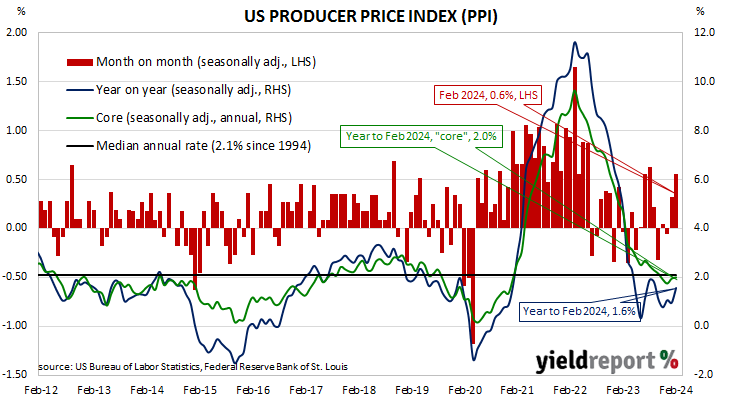Summary: US producer price index (PPI) up 0.6% in February, greater than expected; annual rate accelerates to 1.6%; “core” PPI up 0.3% over month, up 2.0% over year; Citi: disinflation in goods prices ending; US Treasury yields rise; 2024 rate-cut expectations soften; goods prices up 1.2%, services prices up 0.3%.
Around the end of 2018, the annual inflation rate of the US producer price index (PPI) began a downtrend which continued through 2019. Months in which producer prices increased suggested the trend may have been coming to an end, only for it to continue, culminating in a plunge in April 2020. Figures returned to “normal” towards the end of that year but then moved well above the long-term average in 2021 and 2022 before falling back over 2023.
The latest figures published by the Bureau of Labor Statistics indicate producer prices increase by 0.6% after seasonal adjustments in February. The result was greater than the 0.3% increase which had been generally expected as well as January’s 0.3% rise. On a 12-month basis, the rate of producer price inflation after seasonal adjustments and revisions accelerated from January’s revised figure of 1.0% to 1.6%.
Producer prices excluding foods and energy, or “core” PPI, were up 0.3% after seasonal adjustments. The result was in line with expectations but less than January’s 0.5% increase. The annual growth rate remained unchanged at 2.0%.
“Rising goods prices in PPI reinforce our expectation that the disinflation in goods prices over much of last year has largely come to an end,” said Citi Chief Economist Veronica Clark.
The figures came out at the same time as the latest retail sales report and US Treasury bond yields rose noticeably on the day. By the close of business, the 2-year Treasury yield had added 6bps to 4.69%, the 10-year yield had gained 10bps to 4.29% while the 30-year yield finished 9bps higher at 4.44%.
In terms of US Fed policy, expectations of a lower federal funds rate in the next 12 months softened, although several cuts are still currently factored in. At the close of business, contracts implied the effective federal funds rate would average 5.33% in March, in line with the current spot rate, 5.325% in April and 5.305% in May. However, September contracts implied a 4.975% rate, 36bps less than the current rate, while February 2025 contracts implied 4.44%, 89bps less than the current rate.
The BLS stated two thirds of the rise of the index was attributable to a 1.2% increase in goods prices. The final demand services index increased by 0.3%.
The producer price index is a measure of prices received by producers for domestically produced goods, services and construction. It is put together in a fashion similar to the consumer price index (CPI) except it measures prices received from the producer’s perspective rather than from the perspective of a retailer or a consumer. It is another one of the various measures of inflation tracked by the US Fed, along with core personal consumption expenditure (PCE) price data.


